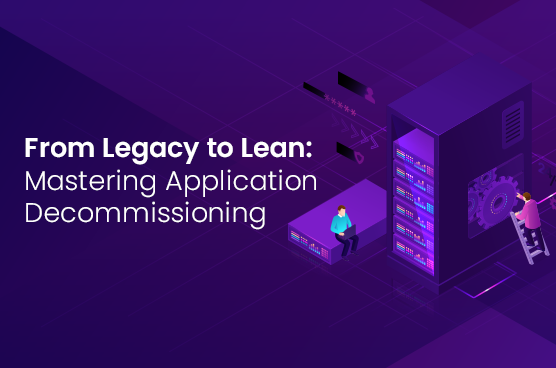_ _ Infobelt
From Legacy to Lean: Mastering Application Decommissioning
Application decommissioning is a crucial process that organizations must undertake to effectively manage their software portfolios. As businesses evolve, they often implement new applications to replace outdated ones. However, many fail to properly retire the old systems, leading to a bloated application landscape that can hinder innovation and pose security risks.
Understanding Application Decommissioning
Application decommissioning involves two main activities:
- Implementing a New Application: This means introducing a new system or service that takes over the functions of the old application.
- Removing the Old Application: This step requires completely eliminating the old application while ensuring that any necessary data is retained for legal or historical reasons.
The Importance of Separation
One of the key findings in effective application management is the need to separate the tasks of replacing an application and decommissioning it. When these processes are combined, organizations often overlook the importance of properly retiring old systems. This oversight can lead to inefficiencies and increased costs.
Challenges in Decommissioning
Decommissioning applications comes with its own set of challenges:
- Regulatory Compliance: Organizations must adhere to legal requirements regarding data retention, which can complicate the decommissioning process.
- Cost Estimation: There is no straightforward formula for estimating decommissioning costs, as they can vary significantly based on factors like complexity and dependencies.
Recommendations for Effective Decommissioning
To improve the success rate of application decommissioning, organizations should consider the following recommendations:
- Delineate Responsibilities: Clearly separate the roles involved in application replacement from those in decommissioning.
- Appoint an Application Manager: Designate a person or team responsible for overseeing decommissioning activities, including defining policies and procedures.
- Evaluate Costs Thoroughly: Assess past ownership costs and consider the scope and complexity of each application when estimating decommissioning expenses.
Managing a Bloated Application Portfolio
Many organizations struggle with maintaining legacy applications, which can be costly and difficult to adapt. A 2021 Gartner survey highlighted that nearly half of respondents identified legacy app maintenance as a top challenge when implementing new technologies. To combat this, leaders must actively work to eliminate outdated applications and streamline their software portfolios.
The Role of an Application Retirement Specialist
The appointed application retirement specialist plays a vital role in ensuring that decommissioning is handled efficiently. They should create a comprehensive decommissioning template that includes:
- Interdependencies: Confirm that no critical processes rely on the old application before proceeding with its removal.
- Licensing Agreements: Address any existing contracts related to the application and ensure all financial obligations are settled.
- Third-Party Services: Notify any external service providers about the termination of services associated with the application.
- Data Retention Policies: Establish clear guidelines for retaining necessary data while ensuring compliance with regulations.
Maintaining a healthy software portfolio
Effective application decommissioning is essential for maintaining a healthy software portfolio. By separating replacement and decommissioning tasks, appointing dedicated oversight, and thoroughly evaluating costs, organizations can eliminate risks associated with outdated applications. This proactive approach not only enhances efficiency but also supports innovation within the business landscape.
Application Decommissioning Checklist
Application decommissioning is the process of retiring outdated systems to streamline operations and enhance security. This guide provides a clear framework for effectively decommissioning applications.
Application Decommissioning Checklist
1. Interdependencies
- Confirm that the application has no remaining dependencies on people, processes, or systems.
- Resolve any identified dependencies before proceeding.
2. Licensing Agreements
- Review existing contracts related to the application.
- Establish payment due dates and notice periods for termination.
- Notify vendors of termination and inform accounts payable to halt further invoices.
3. External Service Providers
- Inform third-party service providers that their services are no longer required.
- Request the handover of all related documentation and source code.
- Ensure data is purged from the third-party environment.
4. Assistance and Upkeep
- Notify support and maintenance staff of the decommissioning.
- Disengage existing help desk and maintenance protocols.
5. Operational Management
- Inform operations managers that the application is no longer in use.
- Review disaster recovery plans to remove references to the application.
6. Development and Testing Environments
- Identify redundant copies of the application in development and support environments.
- Purge unnecessary hardware and return it to the operational pool.
7. Infrastructure Component Licenses
- Check for licenses consumed by associated stack components (e.g., databases).
- Notify license managers of reduced utilization for potential cost savings.
8. Application-Specific Tools
- Assess tools exclusively used by the application for reuse in other environments.
- Purge unused tools and terminate related payments if not reused.
9. Personnel Management
- Engage IT HR early to manage staff redeployment, retraining, or role changes.
- Ensure staff issues are addressed according to corporate policies.
10. Records Management
- Archive artifacts related to the application (e.g., project plans, reports).
- Organize materials for easy retrieval if needed in the future.
11. Historical Data Preservation
- Determine what historic data needs to be retained for compliance or analytics.
- Establish policies for cost-effective data retention and access.
This checklist serves as a comprehensive guide to ensure a smooth and efficient application decommissioning process while minimizing risks and maintaining compliance.
Reference: Gartner Research

